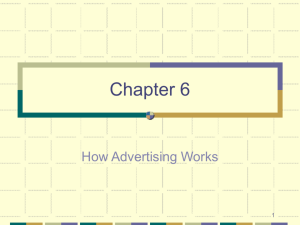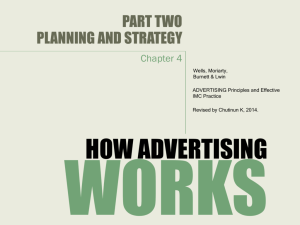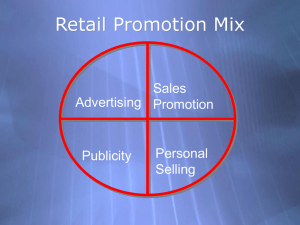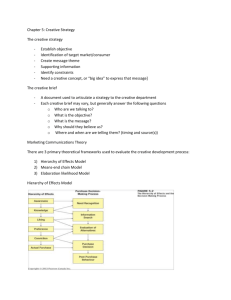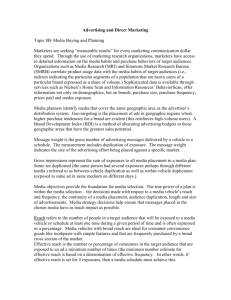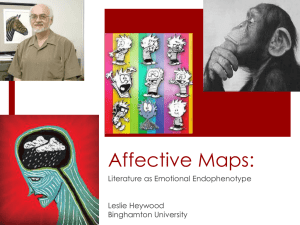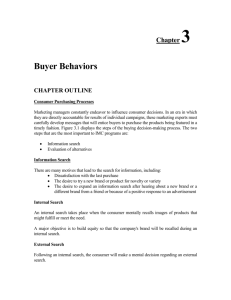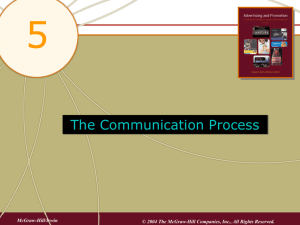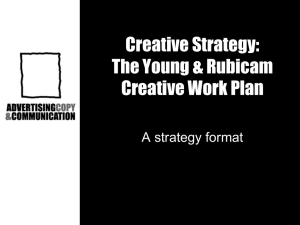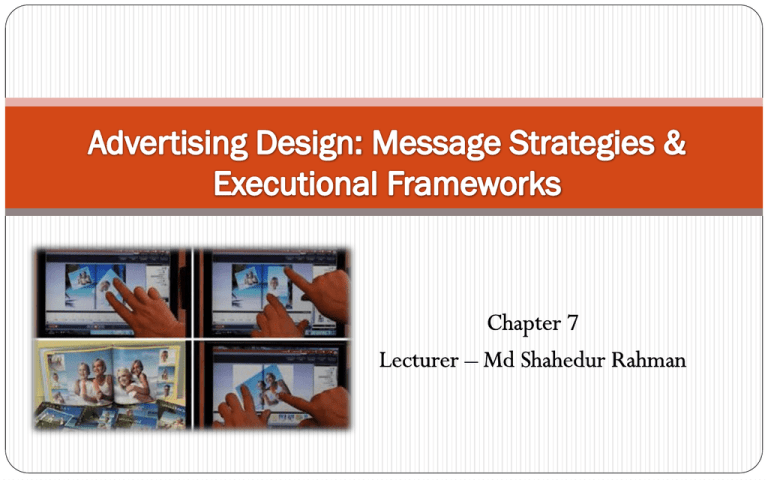
Introduction
Designing messages that effectively reaches the
target audience.
Designed to change or shape attitudes.
Must be remembered.
Should lead to some kind of short or long term
action.
?
Message Strategies
3 broad categories of message strategies:
Cognitive
Affective
Conative
Cognitive Strategies
Presentation of rational arguments or pieces of information to
consumers.
The advertiser’s key message is about the product’s attributes or
benefits.
5 major forms of cognitive strategies:
Generic messages
Preemptive messages
Unique Selling Proposition
Hyperbole
Comparative Advertisements
Cognitive Strategies
Generic Messages –
Direct promotions of product attributes or benefits without any claim
of superiority.
Work best for the brand leaders
Example: Campbell’s Soup – Soup is good food
Preemptive Messages –
Claim superiority based on a product’s specific attribute or benefit.
Idea is to present the competition from making thee same or a similar
statement.
Example: Crest – the cavity fighter
Cognitive Strategies
USP –
A clear, testable claim of uniqueness or superiority that
can be supported or verified.
Example: Dove – 25% moisturizer.
Cognitive Strategies
Hyperbole –
This makes an untestable claim based upon some attribute or
benefits.
Eg. NTV is promoting ‘Bangladeshi’s favorite color GREEN’
Comparative Advertisement –
When an advertiser directly or indirectly compares a good or
service to the competition.
Remember
All five of these cognitive message strategies are based on
some type of rational logic
Ensure consumer pay attention and take time to cognitively
process the information
Informing people about the product
Affective Strategies
Feelings or emotions and match those feelings with the good,
service, or company.
Prepared to enhance the likeability of the product
Recall of the appeal
Affective strategies are a common approach to developing a
strong brand name.
Affective Strategies
The two main forms are:
Resonance advertising
Emotional advertising
Affective Strategies
Resonance Advertising
Connect product with a consumer’s experience to stronger ties
between the product and the consumer
Emotional Advertising
Elicit powerful emotions that eventually lead to product recall and
choice
Many emotions can be connected to products, including trust,
reliability, friendship, happiness, security, romance, passion etc.
Remember about Affective Strategies
Good for developing a strong brand name
Do not make decision based solely on rational thought
process
Emotions and feelings also affect decisions
Conative Strategies
Designed to lead more directly to some type of consumer
response.
Can be used to support other promotional efforts, such as coupon
redemption programs, in-store offers like buy-one-get-one-free.
The 2 main forms are:
Action inducing (suggesting)
Promotional support
Hierarchy of Effects Model
Message
Strategies
Hierarchy of
Effects Model
Advertising
Components
Headline
Sub-headline
Amplification
Proof of the claim
Action to take
Executional Frameworks
Executional Framework
An executional framework is the manner in which an ad appeal is
presented.
It is chosen after an advertising appeal has been selected
Animation
Slice-of-life
Dramatization
Testimonial
Authoritative
Demonstration
Fantasy
Informative
Animation
Has seen a lot of development in
recent years.
Rotoscoping
Clay animation
Slice-of-Life
Here, advertisers try to provide solutions to the everyday
problems customers and businesses face.
P&G came up with the format back in the 1950s.
A common slice-of-life format has 4 stages:
Encounter
Problem
Interaction
Solution
( Banglalink add – dinbodol)
Dramatization
It is similar to the slice-of-life framework.
However, the intensity of the situation is heightened in this
framework.
Make it Big
Testimonials
Especially successful in the B2B and services marketing sectors.
Customer is presented in an ad talking about a positive experience
with a product.
It is an effective method for promoting services.
Testimonials enhance company credibility. In such ads, it is the
everyday people, often actual customers are the main characters –
they are found to be more credible than endorsers and famous
individuals.
Example: BTI – our clients speak for us campaign
Authoritative
The advertiser tries to convince viewers that a given
product is superior to other brands.
Expert authority – dentists, physician, engineer, or
chemist talks about the brand’s advantages compared
to other brands.
Example: Colgate
May include scientific or survey evidence.
Demonstration
It shows how a product works.
Effective way to communicate the attributes of a
product to viewers.
Well-suited to television and internet flash
It is difficult to portray it in other media like
print.
Demonstrations have been found to be effective
for B2B marketing
Fantasy
Such executions are designed to lift the
audience beyond the real world to a
make-believe experience.
Most common fantasy themes still involve
sex, love and romance.
Fantasy is widely used for fragrances and
other fashion items.
Example: AXE
Informative
Here, information is presented to the audience in a
straightforward manner.
Seen commonly in RDCs, rather than in TVC or print – where
consumers tend to ignore them.
Consumers who are highly involved in a particular product
category pay attention to such ads.
Such ads thus tend to work best for high-involvement situations.
Sources and Spokesperson
Sources and Spokespersons
Selecting the right source and spokesperson to use in an
advertisement is a critical decision.
4 types of sources are available to advertisers:
Celebrities – Nokia with Tamim Iqbal
CEOs
Experts – Sunsilk/Persona with Habib, doctors for colgate
Typical persons
Source Characteristics
Matching Source Types and
Characteristics
Amitabh Bachchan
Sachin Tendulkar
If there is a match between the product and celebrity,
the virtue of such an endorsement increases.
Problems
Brand ambassadors bringing disgrace to the brand
Celebrities endorsing too many products – they lose credibility
People know that the celebrities are paid – they lose credibility
Creating an Advertisement
Effective Advertising – Key Points
An effective ad requires the joint efforts of the
account exec, creative, media planner, and media
buyer.
If the ad can break through the clutter – half
the battle is won.
Key points to keep in mind are:
Visual consistency
Campaign duration
Repeated taglines
Consistent positioning – avoid ambiguity (doubt)
Simplicity
Identifiable selling point
Create an effective flow
Beating Ad Clutter
Repetition – it can lead to better brand and
ad recall.
Variability theory
Suggests that variable encoding occurs when a
consumers sees the same advertisement in
different environments. These varied
environments increase an ad’s recall and
effectiveness by encoding it into the brain
through various methods.
Creatives can generate the effect by varying the
situational context of a particular ad.
Example: Mastercard ads or Zoo Zoo
Questions?


